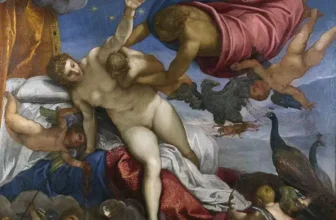
The Martyrdom of St. Lawrence by Titian: History, Symbolism, and Meaning
A Guide for Art Collectors and Antique Painting Enthusiasts
| Invest in Hidden Masterpiece: Rare Antique Oil Paintings For Sale. Limited Originals Available 💰😊 Are you looking for authentic hidden masterpiece? Explore old master antique oil paintings from the Renaissance and Baroque eras. From 16th-century portraits to 18th-century landscapes. Authenticity guaranteed, Old Master antique oil paintings for sale. Shop Now! 🎨 Renaissance And Baroque Art Landscape Antique Paintings Old Master Portrait Paintings |
The world of Renaissance painting is filled with masterpieces that reveal not only technical brilliance but also profound psychological and spiritual depth. Among these rare works stands The Martyrdom of St. Lawrence, painted by **Tiziano Vecellio, known universally as Titian, **one of the most influential figures of the Venetian Renaissance. For art collectors, antique-painting connoisseurs, and historians, this painting holds tremendous cultural, symbolic, and historical value. Its dramatic composition, masterful use of chiaroscuro, and emotionally charged narrative place it among Titian’s most powerful religious works.
This comprehensive guide explores everything you need to know about Titian’s Martyrdom of St. Lawrence: its fascinating history, its rich symbolism, its theological and artistic meaning, and the exact location where the painting resides today. Whether you are an experienced collector, an admirer of Renaissance art, or a researcher seeking a deep scholarly understanding, this article will give you a complete view of this exceptional masterpiece.
Who Was Titian
To appreciate The Martyrdom of St. Lawrence, it is essential to understand the artist who created it. Titian (c. 1488/90–1576) was the undisputed master of Venetian painting. Renowned for his vibrant color palette, expressive brushwork, and psychological realism, he transformed religious iconography into emotionally engaging narratives.
By the time he painted The Martyrdom of St. Lawrence, Titian was already a celebrated figure throughout Italy and the courts of Europe. His patrons included the Habsburg emperors, the papacy, and the most powerful noble families of Venice. His ability to merge classical influences, Christian subjects, and groundbreaking artistic techniques made him one of the defining painters of the Renaissance.
Historical Background of The Martyrdom of St. Lawrence
Commission and Purpose
The Martyrdom of St. Lawrence was created around 1558–1559 for the Church of the Gesuiti (Santa Maria Assunta) in Venice. It was commissioned as part of a cycle celebrating Jesuit devotion, Christian martyrdom, and the triumph of faith over persecution. Titian was nearly 70 years old at the time, a period when his style became increasingly expressive, emotional, and dramatic.
The Subject: Who Was St. Lawrence?
St. Lawrence, one of the most venerated early Christian martyrs, served as a deacon in Rome during the 3rd century. Under Emperor Valerian’s anti-Christian persecution, Lawrence was ordered to surrender the treasures of the Church. Instead, he presented Rome’s poor and marginalized citizens, declaring they were the true treasures. Infuriated, Valerian condemned him to die by being roasted alive on an iron gridiron.
This horrific event became one of the most iconic martyrdom narratives in Christian art.
Titian’s Interpretation
Titian transforms the scene into a dramatic, night-time spectacle filled with movement, firelight, and emotional intensity. Instead of calm, static martyrdom imagery, he offers a violent, visceral depiction that emphasizes:
the drama of martyrdom
the saint’s spiritual triumph
the conflict between earthly violence and heavenly salvation
This makes the work a remarkable example of late Renaissance and proto-Baroque sensibilities.
Composition and Visual Analysis
Masterful Use of Light and Shadow
One of the most striking aspects of the painting is its dramatic lighting. The primary source is the raging fire beneath the gridiron, casting an orange glow that illuminates the saint’s twisting body and the faces of his tormentors. This fiery light contrasts sharply with the surrounding darkness, highlighting Lawrence’s physical suffering while also symbolizing spiritual purification.
The technique foreshadows the Baroque chiaroscuro made famous by Caravaggio, although Titian uses a softer, more atmospheric approach.
The Human Figure and Emotion
Titian’s rendering of St. Lawrence captures both physical agony and spiritual transcendence. The saint’s muscular body twists naturally, revealing the artist’s deep understanding of anatomy. Yet his upward gaze indicates a connection to divine salvation, turning a moment of torture into a narrative of spiritual victory.
Around him, the executioners are rendered in dynamic poses, their gestures suggesting urgency, struggle, and even hesitation. This contrast enhances the saint’s inner calm and saintly resolve.
Architectural and Atmospheric Depth
In the background, dimly lit architectural structures emerge from the darkness, classical columns, arches, and silhouettes that suggest an oppressive Roman environment. The depth and layering of space create a sense of monumental scale, further intensifying the drama.
Symbolism and Meaning: A Deep Interpretation
For collectors and lovers of antique paintings, symbolism is a key element in understanding value, both artistic and historical. The Martyrdom of St. Lawrence is rich with symbolic layers.
1. Fire as Divine Purification
While fire represents agony, it also symbolizes:
purification
spiritual transformation
the presence of the Holy Spirit
The flames beneath the saint illuminate his body, suggesting that suffering leads to sanctification.
2. Upward Gaze: Connection to the Divine
St. Lawrence gazes toward the heavens, an iconographic convention signaling martyrdom’s reward: union with God. The contrast between his upward focus and the downward, earth-bound labor of his executioners reinforces the spiritual hierarchy.
3. Darkness as Spiritual Oppression
The dark background represents the moral and spiritual blindness of the persecutors. Lawrence, illuminated by divine light, becomes a symbol of Christian truth shining in a corrupt world.
4. The Grid Iron as Symbol of Witness
The gridiron became not only Lawrence’s instrument of death but also his emblem in Christian iconography. Its presence in the painting emphasizes the saint’s identity and his steadfastness under persecution.
5. Composition as Allegory of Good Versus Evil
The dichotomy between light and shadow, serenity and violence, heaven and earth reflects the deeper Christian narrative of the triumph of good over evil. Titian uses every element to show the saint’s inner victory despite physical defeat.
Why This Painting Is Important
1. It Represents a Crucial Phase of Titian’s Late Style
Collectors and scholars value works that reflect an artist’s mature phase. This painting exemplifies Titian’s bold, expressive, emotionally driven late period, a time when his brushwork became freer and more textured.
2. It Demonstrates Early Baroque Drama
Although painted in the late Renaissance, it anticipates the theatrical intensity of the Baroque movement. This makes it a link between major art historical periods, increasing its academic and cultural value.
3. Its Provenance Is Highly Significant
Commissioned by a major Venetian church, preserved through centuries, and associated with significant religious devotion, the work has a strong documented history, one of the key considerations for collectors of antique art.
4. It Represents a Canonical Christian Theme
Martyrdom scenes are a staple of Christian iconography. Titian’s interpretation stands among the most influential and visually powerful versions, making it a cornerstone reference for collectors of sacred art.
5. An Outstanding Example of Venetian Colorism
Titian was synonymous with color. The glowing reds, burning oranges, and smoky blacks create an atmosphere that collectors deeply appreciate for its emotional resonance and technical sophistication.
The Actual Location of Titian’s Martyrdom of St. Lawrence
Today, The Martyrdom of St. Lawrence is housed in the Church of the Jesuits, also known as the Chiesa di Santa Maria Assunta (I Gesuiti) in Venice, Italy.
Visiting the Painting
The church is located in the Cannaregio district of Venice, near the Fondamente Nove. Inside, the painting remains in a chapel where it continues to be admired by art historians, travelers, and pilgrims alike. Its atmospheric display within the dim interior enhances its dramatic lighting and emotional impact.
For collectors visiting Venice, seeing the painting in its intended location is an unforgettable experience that offers a deeper understanding of Titian’s vision.
Comparisons to Other Martyrdom Works by Titian
Titian painted multiple martyrdom scenes throughout his career. Comparing them reveals his evolving approach to drama, lighting, and symbolism.
1. The Martyrdom of St. Peter of Verona
One of Titian’s earliest major religious works, this painting showcases a more structured and classical style. Compared to the emotional intensity of St. Lawrence, it feels more controlled and less atmospheric.
2. The Martyrdom of St. Lawrence (Escorial Version)
There is another version commissioned by King Philip II of Spain, housed in the Escorial. This later painting is darker, more mystical, and more abstract in its composition. Many scholars believe that Titian refined his ideas through multiple interpretations of the subject.
3. The Martyrdom of St. Sebastian (lost)
Titian’s lost St. Sebastian martyrdom, known through copies, likely shared thematic similarities but explored different emotional tones. These variations show Titian’s continuous experimentation with martyrdom imagery, emphasizing his fascination with human suffering and spiritual transcendence.
Techniques and Restoration History
Over centuries, The Martyrdom of St. Lawrence has undergone various cleaning and conservation processes due to:
darkened varnish
fire and smoke exposure
environmental factors within the church
Restorations have revealed:
Titian’s subtle brushwork
layers of glazing
his characteristic blending of warm and cool tones
details previously obscured by oxidized varnish
Modern conservation has stabilized the painting, ensuring its preservation for future generations.
Important Key Points
1. A Masterclass in Renaissance Emotional Narrative
Collectors prize paintings that convey powerful storytelling. Titian’s St. Lawrence offers a visually compelling and emotionally charged scene that demonstrates mastery of narrative depth.
2. A Study in Chiaroscuro Evolution
For those studying the development of chiaroscuro techniques, this painting represents a transitional moment leading toward Baroque dynamism.
3. Cultural and Religious Significance
Its resonance with Catholic symbolism makes it especially important for collectors of Christian art and institutions dedicated to preserving sacred heritage.
4. A Testament to Titian’s Influence
The painting inspired generations of artists, including:
Caravaggio
Rubens
Ribera
Tintoretto
Owning or studying works influenced by this masterpiece enriches a collector’s understanding of its lasting impact.
The Martyrdom of St. Lawrence is a major religious painting by Titian.
Painted c. 1558–1559 for the Jesuit Church of Santa Maria Assunta in Venice.
Depicts the martyrdom of St. Lawrence on a gridiron.
Symbolizes spiritual triumph, purification, and divine light.
Exemplifies Titian’s late Renaissance style and proto-Baroque elements.
Currently located in the Chiesa di Santa Maria Assunta (I Gesuiti), Venice.
Highly valued for its historical, technical, and symbolic depth.
Why This Painting Matters
Titian’s Martyrdom of St. Lawrence stands as one of the most astonishing depictions of martyrdom in Renaissance art. Its compelling combination of dramatic lighting, emotional depth, religious symbolism, and technical mastery makes it a vital reference for art collectors and antique-painting enthusiasts. The painting captures the essence of Venetian artistry while illustrating the universal themes of sacrifice, faith, and the enduring human spirit.
Understanding the historical and symbolic layers of this masterpiece significantly enhances appreciation of the artist’s genius. Visiting the painting in its Venetian setting adds another dimension, allowing viewers to experience it as Titian intended, surrounded by darkness, illuminated by its own fire, and echoing with centuries of devotion.
The Martyrdom of St. Lawrence is a timeless meditation on suffering and salvation, a monumental work that continues to inspire awe more than four centuries after its creation.




